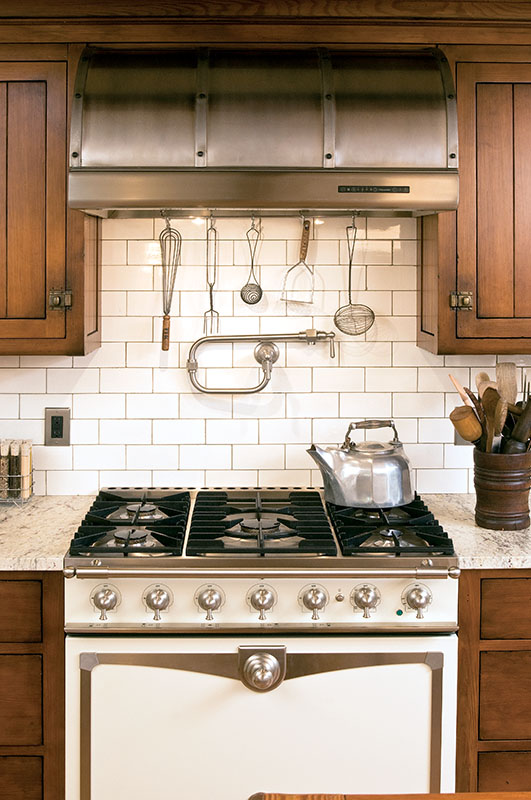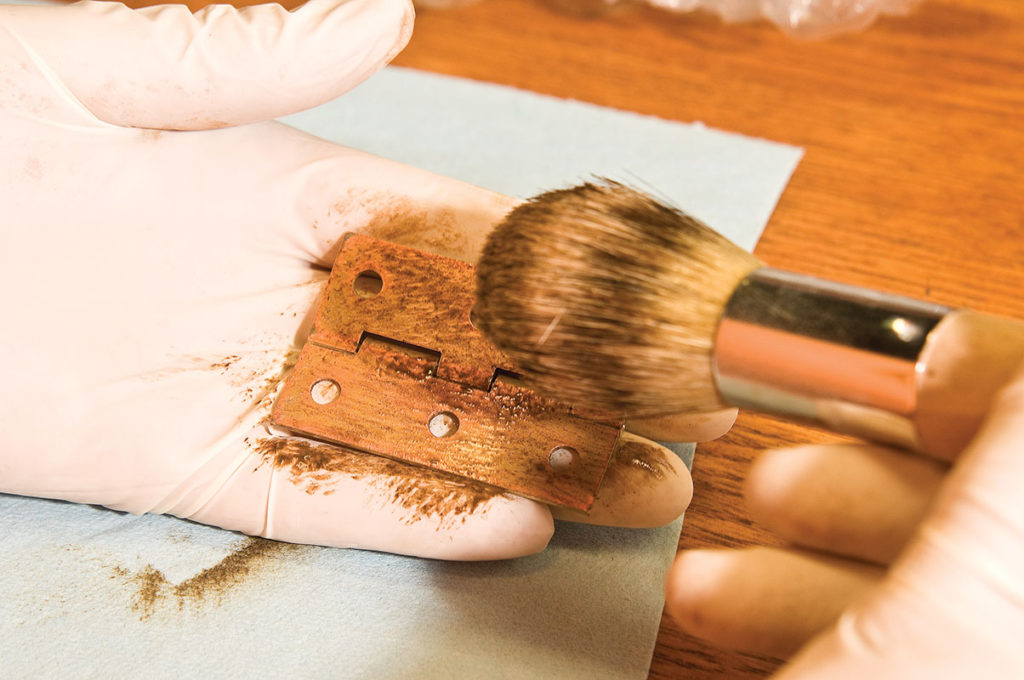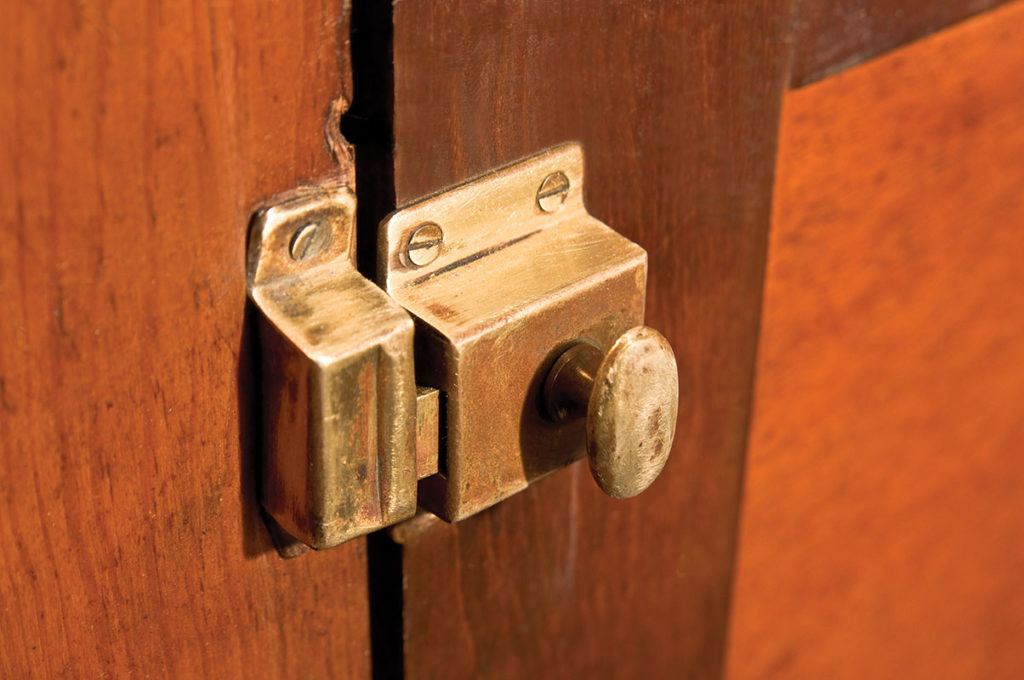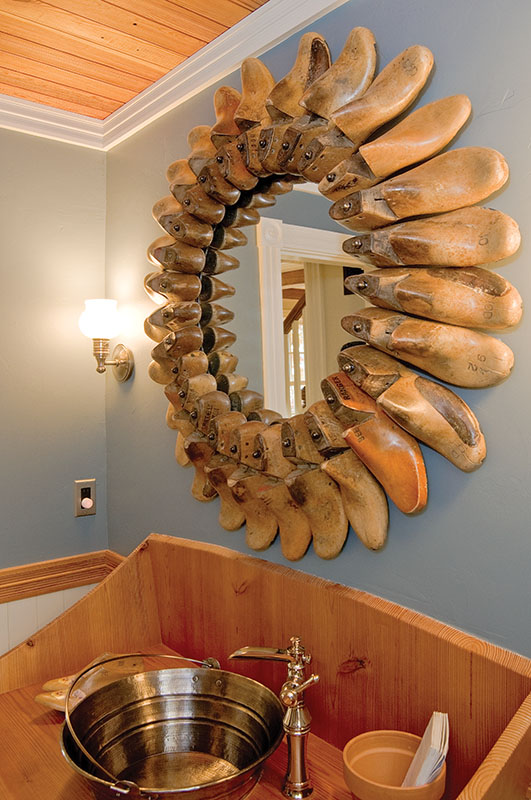The kitchen was designed by Lauren Frye; custom finishes are by Guy DiMatteo of Artisan Finishing Services. A custom plate rack hangs above a period-style Kohler sink. A soft-pleated fabric skirt, fastened with Velcro, offers colorful coverage for the under-sink area.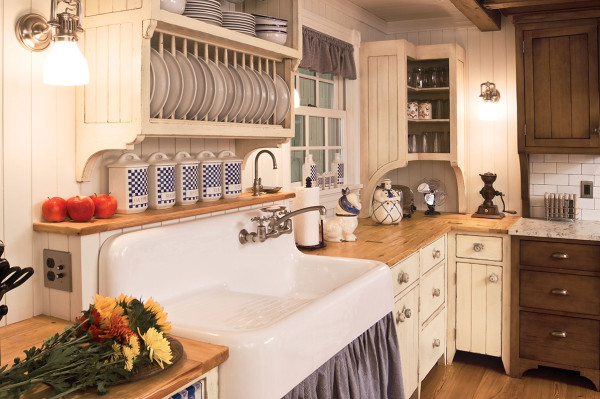
Photos by Andy Oleic
There’s a term among vintage car collectors that describes retaining the original look of a car while updating its technology with modern parts to enhance performance, comfort, and safety: restomod (restoration + modern). For Francis Cosentino, a retired advertising executive and an avid collector of fine performance and race cars, restomodding is just as important to the thoughtful renovation of a historic home.
“We bought Fostoria five years ago as our summer home, after waiting for years to find just the right place,” Fran says. “We spent two years restoring it in detail. It’s more work than building a new house, but preserving the character and history of the house is important to us.”
Main living spaces like the dining room feature original beadboard, cleaned and waxed by the owners. Hutch, table, and chairs were collected over the years.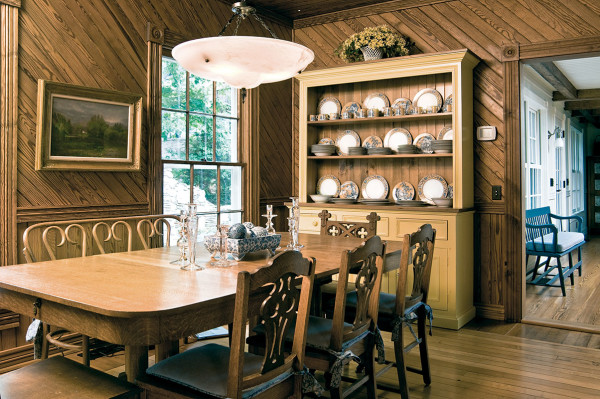
Nestled along the western shoreline of New York’s Canandaigua Lake, in the Finger Lakes region, the house called Fostoria was once part of a 200-acre fruit farm. Built in 1900 by William Foster Sr., the two-storey farmhouse later served as a packinghouse and residence for workers on the farm. William and his wife, Eliza, gave the house to their son William Jr., in 1905, as a wedding gift. William Jr. raised his family in the house while continuing the farm’s thriving business. Apples, peaches, and other fruit were picked up by steamboat at Fostoria and then shipped by train to locations across the country. The constructed peninsula that extended past the shallow shoreline to serve as a loading dock in deeper water exists today, comprising 200 feet of the home’s 400 feet of lake frontage on its current 2.2-acre lot.
An authentic harvest table features heart pine from the Carolinas.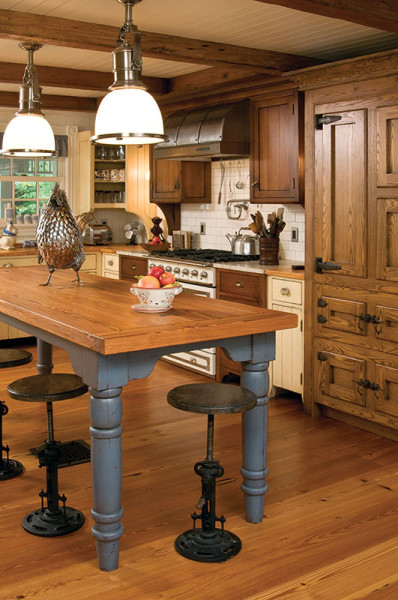
Fran and his wife, Jane Parker, an international ballroom-dance competitor, are only the second owners outside of the Foster family, who owned the home until 1999. The house had seen little upgrade or renovation over its first hundred years. The previous owner had installed some new windows, and relocated the stone fireplace from the center of the living room to the wall backing the kitchen. That was part of what drew Fran and Jane to the house: three-quarters of it retained original character, which was something they wanted to preserve.
No newcomers to historical renovation, Fran and Jane had just finished restoring the distinguished Edward E. Boynton House, the only example of Frank Lloyd Wright’s work in the greater Rochester, New York, area. They had a tried-and-true team in place, for everything from HVAC to carpentry and landscaping.
“There is virtually no part of the house that we didn’t touch,” Fran says. “We upgraded the HVAC from a coal-fired hot-air system to gas-fired hot water, updated plumbing and electrical, restored woodwork and flooring throughout the house, and renovated the kitchen to bring it closer to what would have been authentic for that era.”
Working within the existing kitchen’s footprint, Fran and Jane consulted with designer Lauren Frye of Willow Grove Design to bring to life their vision of an aesthetically period-appropriate yet functional kitchen that would blend seamlessly with the rest of the house. One of the biggest challenges was finding wall space for a more centrally located sink. With two direct entryways from the porch to the kitchen, and limited wall space for cabinets, they decided to remove the exterior door that opened awkwardly from the center of the kitchen. Now a farmhouse sink and custom plate rack fill the space, and the existing windows on either side offer gorgeous views across the lushly landscaped property toward the lake.
This is a view of the old lake house from the west side: a new pergola connects guest house and main house.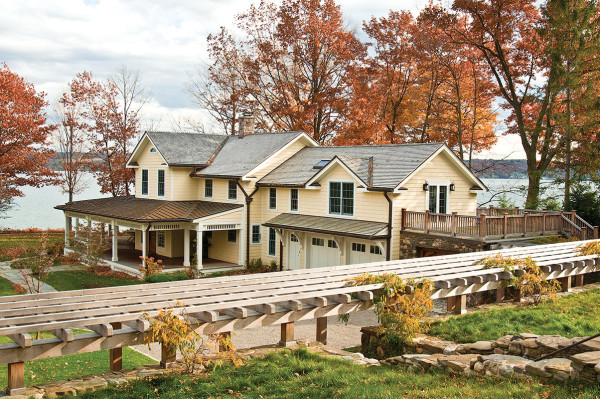
The couple also replaced the kitchen floor with heart pine that matches the wood used for the countertops and the farm table at the center of the kitchen. Custom cabinetry, including a vintage-looking icebox that conceals a refrigerator and freezer, were carefully distressed to look authentic and of the period. Fran often added his own finishing touches, such as drilling and then filling holes in some of the cabinets to replicate the wear and tear that would happen over years of use. He also developed a method to antique cabinet hardware, using Allbäck Linseed Oil Wax.
“I’m very hands-on and thorough,” he says. “I love resourcing the materials, and the creativity and investigative work needed to do justice to the character of the house. I get a deep level of satisfaction from restoring a home like this.”
The more time you spend at Fostoria, the more detail you appreciate, the more you see how thoughtful was the attention paid during restoration: the trimwork in the kitchen that unites with existing trim in adjoining rooms (and that required custom moulding knives); the delicate rosewood inlays that carry from countertop to farm table, echoing tones in the beadboard in the adjacent living spaces; the harmonious blend of natural wood with painted wood in hues mirrored in furnishings; strategically placed lighting barely visible to the eye, yet which brightens corners and dreary days; and visible appliances that are period appropriate, with modern ones tucked away from view while still providing today’s comfort and convenience.
HOW TO: Antique Hardware
Whether on wood or metal, natural patina is achieved over a long period of time as dirt, oils, and UV light affect the surface. To blend new hardware into a vintage scheme, you can achieve a similar aging
effect with a few hours of work, simple tools, and patience.
1. First, lightly roughen the surface with steel wool, a wire brush, or fine-grit sandpaper (150 to 220 grit). If the hardware has a lacquer finish, strip it with lacquer thinner, before sanding, then roughen
the surface.
2. Use a stencil brush with soft and flexible natural bristles to apply the oil-based glaze (this homeowner used a dark chocolate-brown glaze) to the roughened surface. With a dry brush, soft cotton pad, or your fingers, rub the glaze into the surface until you have a patina-like effect.
3. Let it dry for 48 hours so it’s dry to the touch, and repeat the process until you have the look you want. Be patient or it might look contrived. Once you’re satisfied, let the hardware dry, unused, for about a week.
4. For wood surfaces, you can use a similar technique. Or try a tinted wax such as Allbäck Linseed Oil Color Wax, but do not sand the wood first.



